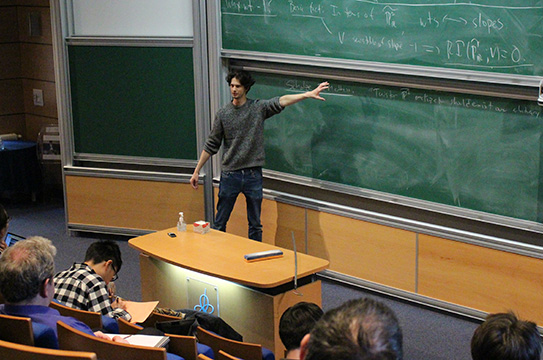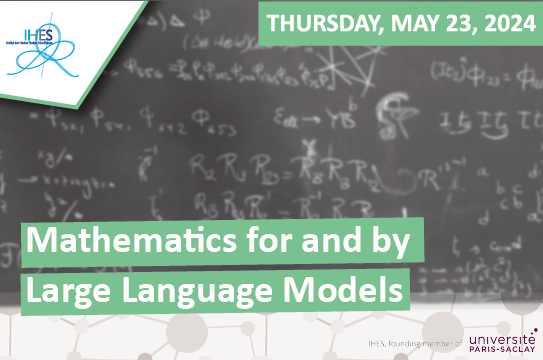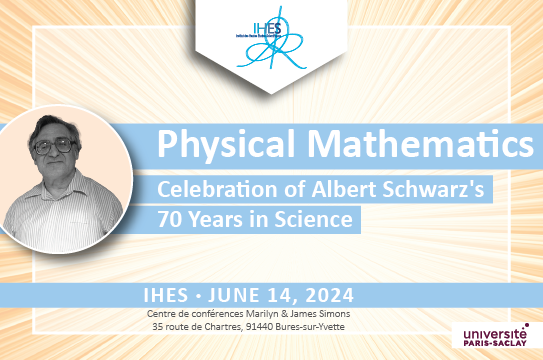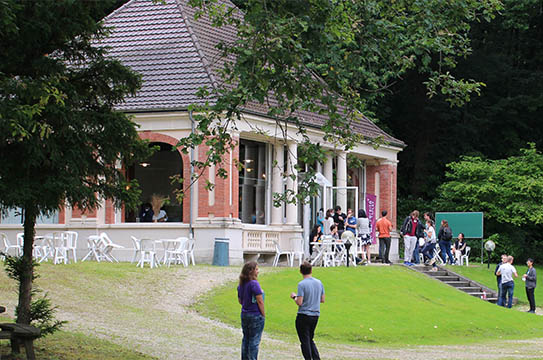 IHES
IHES
Interview with Dustin Clausen
Dustin Clausen joined IHES in April 2023 as a permanent professor in mathematics. In this interview he talks about his relationship with mathematics and about what being at IHES means to him. He also gives us a glimpse into his research interests.
• What drew you to mathematics?
At the beginning, it was two aspects. The first was the possibility of definite answers. In mathematics, as opposed to many other human affairs, statements can be precisely formulated, and will simply either be true or false. As a young person in an uncertain world, I was drawn to this certainty. The second reason was the sense of independence that mathematics provides. One doesn’t need to accept any authority; one can verify everything oneself by following the logic. Later, I also came to appreciate what could be called beauty in mathematics. The rigid structure of mathematics generates a world of incredible depth, intricacy, and wonder, where, perhaps paradoxically, human creativity can really flourish. In a way one sees a similar connection between rigidity and creativity in other artistic disciplines: many times in history groups of artists have set rules for themselves in order to focus their creative force. But in mathematics the rules are set by nature itself, and generate a world whose structure goes well beyond what man-made rules could yield.
• What does being a permanent professor at IHES mean to you?
The position of permanent professor at IHES is, for me, the ultimate instantiation of the independence and freedom I’ve always been striving for. Here, I feel that I can truly just work. I am endlessly grateful that a place like this exists, and that I was offered such a position here.
• What are the research projects that you are planning to work on in the near future?
With Peter Scholze, and based on the groundbreaking work of Alexander Efimov, I have been investigating the K-theory of analytic spaces. Peter and I formulated a conjecture saying that this K-theory in the world of complex analytic spaces should just be a form of Deligne cohomology, and I’m very interested in trying to prove this conjecture. Meanwhile, in chromatic homotopy theory, a new door has been opened due to the resolution (in the negative!) of the telescope conjecture by Robert Burklund, Jeremy Hahn, Ishan Levy, and Tomer Schlank. I may devote some time to trying to understand what structure is truly present in telescopic homotopy theory given this disproof of the original vision.
• What do you work on?
In broad terms, I tend to work on linear algebra. This sounds simple, and simplicity is indeed one of the main appeals of linear algebra. But it is also remarkably powerful. Naively, one might think that linear algebra is limited, because, geometrically speaking, it can only describe flat objects. After all, solutions to linear equations are always flat. But a surprising shift in perspective shows that linear algebra can capture all kind of geometric objects. Namely, one thinks not of plain linear algebra, but of the manner in which linear algebraic structure can vary from point to point in a given geometric object. For example, the fact that there are no consistent global coordinates on a sphere (the surface of the Earth, say) tells us something about the shape of the sphere. With Peter Scholze, I have recently developed an extension of linear algebra, which allows to describe ever more intricate geometry. We call this extension “condensed mathematics”, and the idea is to marry linear algebra and topology at the very level of foundations, allowing for a richer class of basic linear algebraic objects, and consequently richer geometric objects.
A related theme which runs through my work is that of K-theory. A fundamental fact in linear algebra is that finite-dimensional vector spaces are classified uniquely by their dimension. In other words, there’s only one kind of flat space in every dimension. But the situation changes when one thinks about finite dimensional spaces which vary over a geometric object, as in the previous paragraph. More precisely, such objects are known as vector bundles, and a vector bundle requires more information than just its dimension to determine it, because the linear algebra can get “twisted” when one changes the point continuously. The basic example of this is the famous Möbius band. Here the geometric object is the circle sitting at the center of the Möbius band, and the perpendicular slices can be thought of as one-dimensional vector spaces varying in a “twisted” manner with the point on the circle.
The nature of the possible twistings depends very much on the geometric object one starts with, to such an extent that the classification of vector bundles gives us a lot of information about the geometry. One instantiation of this is the K-theory of Alexandre Grothendieck, which is remarkably adept at converting linear algebra into geometrically relevant information. The idea is that we simplify the classification of vector bundles by only considering certain particularly well-behaved so-called “additive” invariants of vector bundles, these being variants of the familiar dimension function. It turns out that there are enough of these additive invariants that the theory gives a lot of information, but not too many that we have no hope of understanding it. I have studied linear algebra and K-theory in many different settings, from number theory to algebraic topology to analysis, but my motivation and understanding often came from geometry.
Another major aspect of my work is the systematic use of homotopy-theoretic methods. Fundamentally, doing homotopy theory means paying very special attention to what is meant by equality. Often, when we say that two things are equal, what we mean is that we have a way of viewing them as being the same, or more precisely, that we have an identification between them. In homotopy theory, one takes this very seriously: the possible identifications are viewed as fundamental objects themselves, worthy of the same detailed study as the original things being identified. Pursuing this idea quickly leads to an infinite hierarchy: one must then also study the ways of identifying different identifications, and so on up to infinity. The origins of homotopy theory come from topology: given a space, one can say that two points are “the same” if they can be connected by a path, that two paths are the same if they can be connected by a path of paths, and so on. For example, on a circle, all points are “the same” in this sense, but more precisely two points can be viewed as the same in many different ways: one can go around the circle any number of times (clockwise or counterclockwise) before ending up at the second point. One says that “the fundamental group of the circle is the group of integers Z”, and this gives a way of capturing the geometric/topological fact that a circle is made to enclose 2-dimensional regions without passing through them.
However, homotopy theory has relevance well beyond its origins in topology, as the situation of considering identifications between identifications and so on arises in many situations with no a priori connection to paths in space. One such situation is precisely in K-theory. There, we decided to identify two vector bundles when every additive invariant yields the same result on both of them. But there is a more fundamental way of expressing when this happens, or rather how it happens, and then the question of identifications between identifications, and so on, arises. The resulting theory called higher algebraic K-theory, was developed flexibly by Daniel Quillen, and has been put to great use in the many fields where K-theory has relevance. It is higher algebraic K-theory that has been a particular focus of mine. To make serious progress in higher algebraic K-theory, one needs a flexible and faithful language for discussing homotopy-theoretic matters. Thankfully, such a language has been provided by my Ph.D. advisor Jacob Lurie, who spent a long time developing the foundations of what is called infinity categories, these being the native environments where homotopy theory happens. Like many researchers these days who rely on homotopy-theoretic techniques, I freely use infinity categories in my work.
However, in the end, despite all this talk of linear algebra, K-theory, homotopy theory, and infinity categories, my basic interest in mathematics is number theory. I started to study K-theory because as a PhD student, I discovered a truly new proof of a basic fact in number theory, the quadratic reciprocity law, and I realized that K-theory provided the correct language for expressing this proof. I quickly pushed the method to recover a more serious reciprocity law, the Artin reciprocity law. Since then I have made many attempts to generalize further to the fascinating and deep extensions of the reciprocity law which one finds in the Langlands program. So far, I have not had success, but this is my greatest goal: to understand the Langlands program in a similar way to how I’ve understood the Artin reciprocity law. I hope that the study of linear algebra, K-theory, and homotopy theory that I’ve done in the meantime will help me with this. But even more, I hope that other people will get interested in the same problem as well! But for this, I probably need to figure out some program or path that could be followed.



